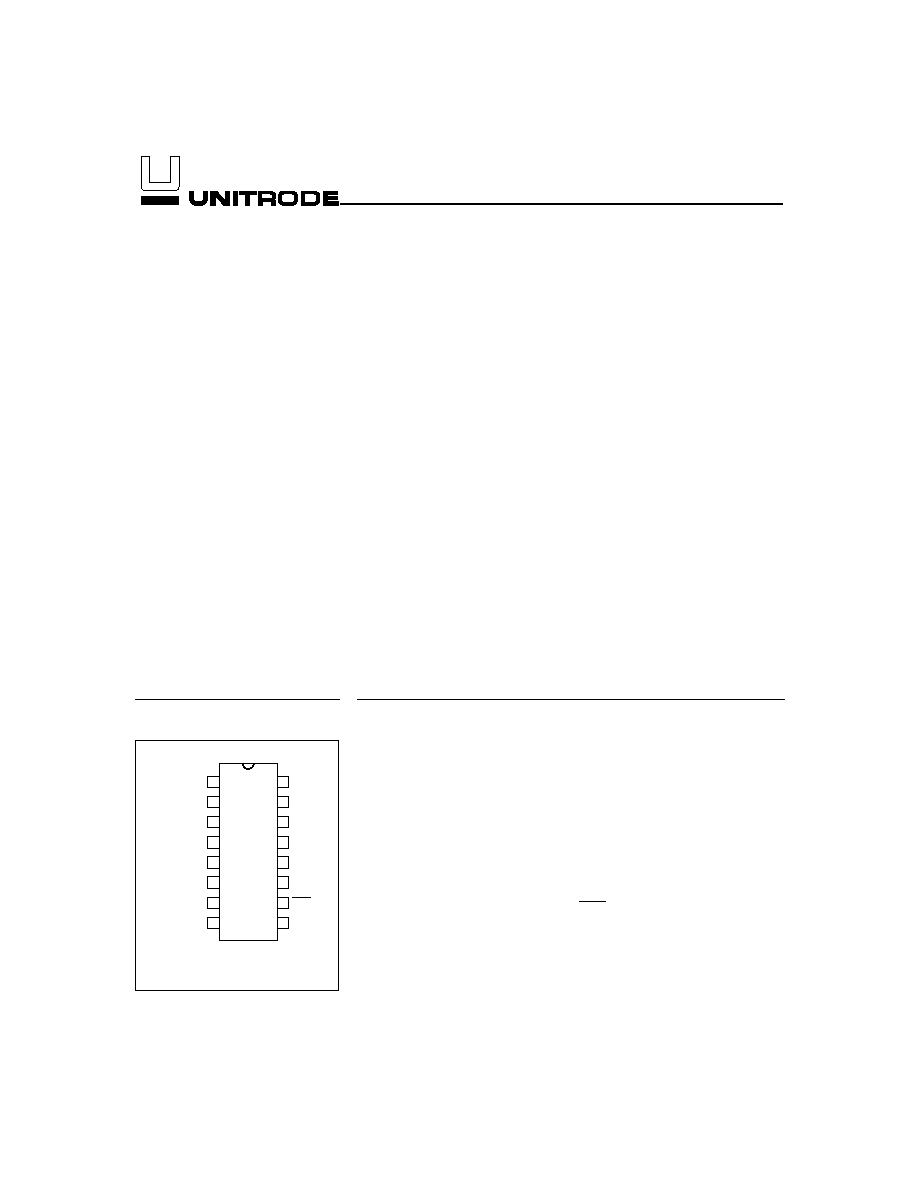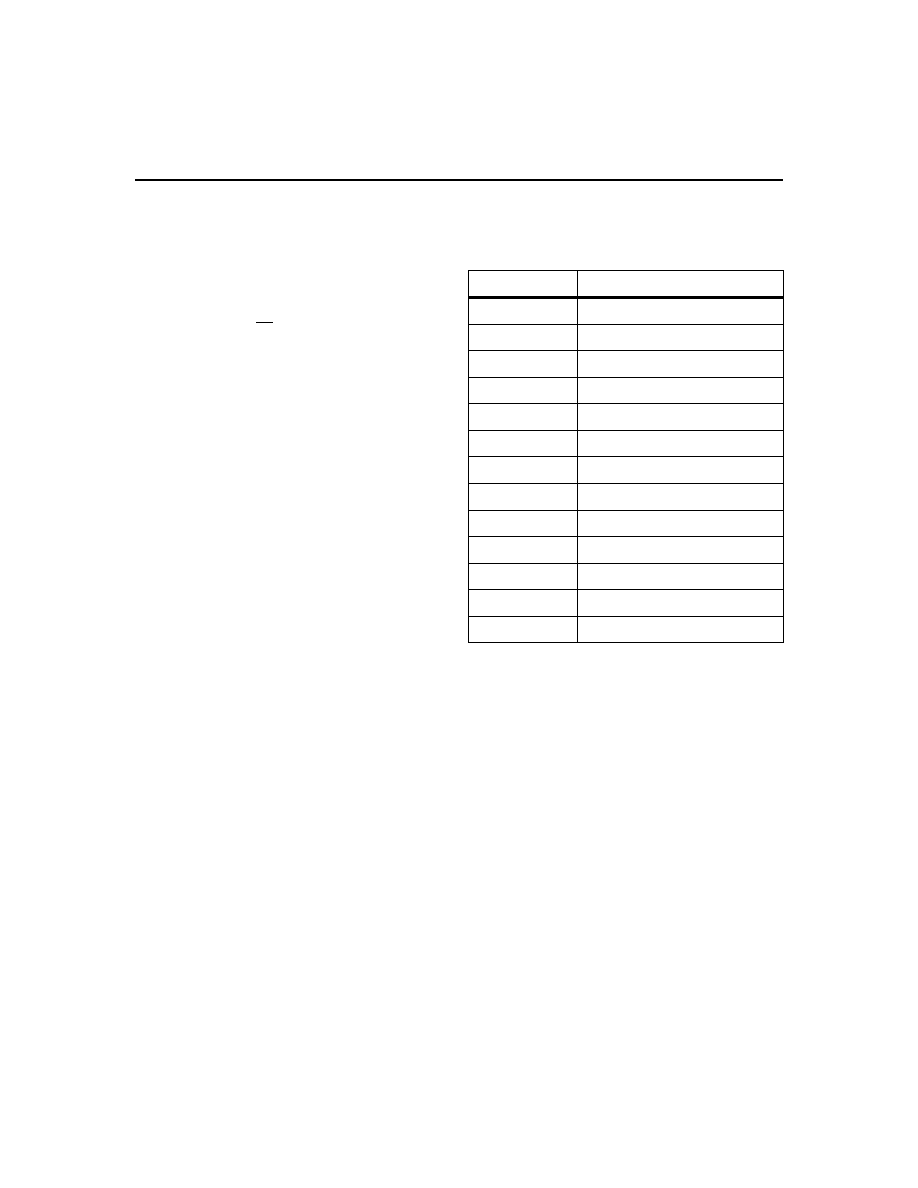 | ÐлекÑÑоннÑй компоненÑ: BQ2014SN | СкаÑаÑÑ:  PDF PDF  ZIP ZIP |
Äîêóìåíòàöèÿ è îïèñàíèÿ www.docs.chipfind.ru

1
Features
Conservative and repeatable
measurement of available charge
in rechargeable batteries
Charge control output operates an
external charge controller such as
the bq2004 Fast Charge IC
Designed for battery pack inte-
gration
-
120
µA typical standby current
Display capacity via single-wire
serial communication port or di-
rect drive of LEDs
Measurements compensated for
current and temperature
Self-discharge compensation using
internal temperature sensor
User-selectable end-of-discharge
threshold
Battery voltage, nominal avail-
able charge, temperature, etc.
available over serial port
16-pin narrow SOIC
General Description
The bq2014 Gas Gauge IC is in-
tended for battery-pack or in-system
installation to maintain an accurate
record of available battery charge.
The IC monitors the voltage drop
across a sense resistor connected in
series between the negative battery
terminal and ground to determine
charge and discharge activity of the
battery.
Self-discharge of NiMH and NiCd
batteries is estimated based on an
internal timer and temperature sen-
sor. Compensations for battery tem-
perature and rate of charge or dis-
charge are applied to the charge, dis-
charge, and self-discharge calcula-
tions to provide available charge in-
formation across a wide range of op-
erating conditions. Battery capacity
is automatically recalibrated, or
"learned," in the course of a dis-
charge cycle from full to empty.
The bq2014 includes a charge con-
trol output that controls an external
Fast Charge IC such as the bq2004.
Nominal Available Charge (NAC)
may be directly indicated using a
five-segment LED display.
The bq2014 supports a simple single-
line bidirectional serial link to an ex-
ternal processor (with a common
ground). The bq2014 outputs battery
information in response to external
commands over the serial link.
Internal registers include available
charge, temperature, capacity, bat-
tery voltage, battery ID, battery
status, and programming pin set-
tings. To support subassembly test-
ing, the outputs may also be con-
trolled. The external processor may
also overwrite some of the bq2014
gas gauge data registers.
The bq2014 may operate directly
from three or four cells.
With the
REF output and an external transis-
tor, a simple, inexpensive regulator
can be built to provide V
CC
across a
greater number of cells.
LCOM
LED common output
SEG
1
/PROG
1
LED segment 1/
program 1 input
SEG
2
/PROG
2
LED segment 2/
program 2 input
SEG
3
/PROG
3
LED segment 3/
program 3 input
SEG
4
/PROG
4
LED segment 4/
program 4 input
SEG
5
/PROG
5
LED segment 5/
program 5 input
DONE
Fast charge complete
1
PN201401.eps
16-Pin Narrow SOIC
2
3
4
5
6
7
8
16
15
14
13
12
11
10
9
LCOM
SEG1/PROG1
SEG2/PROG2
SEG3/PROG3
SEG4/PROG4
SEG5/PROG5
DONE
VSS
VCC
REF
CHG
DQ
EMPTY
SB
DISP
SR
REF
Voltage reference output
CHG
Charge control output
DQ
Serial communications
input/output
EMPTY
Empty battery indicator
output
SB
Battery sense input
DISP
Display control input
SR
Sense resistor input
V
CC
3.06.5V
V
SS
System ground
12/95 C
Pin Connections
Pin Names
bq2014
Gas Gauge IC with External Charge Control

Pin Descriptions
LCOM
LED common output
Open-drain output switches V
CC
to source
current for the LEDs. The switch is off dur-
ing initialization to allow reading of the soft
pull-up or pull-down programming resistors.
LCOM is also in a high impedance state
when the display is off.
SEG
1
SEG
5
LED display segment outputs (dual func-
tion with PROG
1
--PROG
5
)
Each output may activate an LED to sink
the current sourced from LCOM.
PROG
1
PROG
5
Programmed full count selection imputs
(dual function with SEG
1
--SEG
5
)
These three-level input pins define the pro-
grammed full count (PFC) thresholds de-
scribed in Table 2.
PROG
3
PROG
4
Gas gauge rate selection inputs (dual
function with SEG
3
--SEG
4
)
These three-level input pins define the pro-
grammed full count (PFC) thresholds de-
scribed in Table 2.
PROG
5
Self-discharge rate selection (dual func-
tion with SEG
5
)
This three-level input pin defines the self-
discharge compensation rate shown in Ta-
ble 1.
CHG
Charge control output
This open-drain output becomes active high
when charging is allowed.
DONE
Fast charge complete
This input is used to communicate the
status of an external charge controller such
as the bq2004 Fast Charge IC. Note: This
pin must be pulled down to V
SS
using a
200K
resistor.
SR
Sense resistor input
The voltage drop (V
SR
) across the sense re-
sistor R
S
is monitored and integrated over
time to interpret charge and discharge activ-
ity. The SR input is tied to the high side of
the sense resistor. V
SR
< V
SS
indicates dis-
charge, and V
SR
> V
SS
indicates charge. The
effective voltage drop V
SRO
, as seen by the
bq2014, is V
SR
+ V
OS
(see Table 5).
DISP
Display control input
DISP high disables the LED display. DISP
tied to V
CC
allows PROG
X
to connect di-
rectly to V
CC
or V
SS
instead of through a
pull-up or pull-down reistor. DISP floating
allows the LED display to be active during
a valid charge or during discharge if the
NAC register is updated at a rate equiva-
lent to V
SRO
-4mV. DISP low activates
the display. See Table 1.
SB
Secondary battery input
This input monitors the single-cell voltage
potential through a high-impedance resis-
tive divider network for the end-of-discharge
voltage (EDV) thresholds,maximum charge
voltage (MCV), and battery removed.
EMPTY
Battery empty output
This
open-drain
output
becomes
high-
impedance on detection of a valid final end-
of-discharge voltage (V
EDVF
) and is low fol-
lowing the next application of a valid charge.
DQ
Serial I/O pin
This is an open-drain bidirectional pin.
REF
Voltage reference output for regulator
REF provides a voltage reference output for
an optional micro-regulator.
V
CC
Supply voltage input
V
SS
Ground
2
bq2014

Functional Description
General Operation
The bq2014 determines battery capacity by monitoring
the amount of charge input to or removed from a re-
chargeable battery. The bq2014 measures discharge and
charge currents, estimates self-discharge, monitors the
battery for low-battery voltage thresholds, and compen-
sates for temperature and charge/discharge rates. The
charge measurement is made by monitoring the voltage
across a small-value series sense resistor between the
battery's negative terminal and ground. The available
battery charge is determined by monitoring this voltage
over time and correcting the measurement for the envi-
ronmental and operating conditions.
Figure 1 shows a typical battery pack application of the
bq2014 using the LED display capability as a charge-
state indicator. The bq2014 is configured to display ca-
pacity in a relative display mode. The relative display
mode uses the last measured discharge capacity of the
battery as the battery "full" reference. The LED seg-
ments output a percentage of the available charge based
on NAC and LMD.
A push-button display feature is
available for momentarily enabling the LED display.
The bq2014 monitors the charge and discharge currents
as a voltage across a sense resistor (see R
S
in Figure 1).
A filter between the negative battery terminal and the
SR pin is required.
3
bq2014
Figure 1. Battery Pack Application Diagram--LED Display,

Voltage Thresholds
In conjunction with monitoring V
SR
for charge/discharge
currents, the bq2014 monitors the single-cell battery po-
tential through the SB pin. The single-cell voltage po-
tential is determined through a resistor/divider network
per the following equation:
R
R
N
2
3
1
=
-
where N is the number of cells, R2 is connected to the
positive battery terminal, and R3 is connected to the
negative battery terminal. The single-cell battery volt-
age is monitored for the end-of-discharge voltage (EDV)
and for maximum cell voltage (MCV). EDV threshold
levels are used to determine when the battery has
reached an "empty" state, and the MCV threshold is used
for fault detection during charging.
Two EDV thresholds for the bq2014 are programmable
with the default values fixed at:
EDV1 (early warning) = 1.05V
EDVF (empty) = 0.95V
If V
SB
is below either of the two EDV thresholds, the as-
sociated flag is latched and remains latched, independ-
ent of V
SB
, until the next valid charge (as defined in the
section entitled "Gas Gauge Operation"). The V
SB
value
is also available over the serial port.
During discharge and charge, the bq2014 monitors V
SR
for various thresholds. These thresholds are used to
compensate the charge and discharge rates. Refer to the
count compensation section for details. EDV monitoring
is disabled if V
SR
-250mV typical and resumes ½ sec-
ond after V
SR
> -250mV.
EMPTY Output
The EMPTY output switches to high impedance when
V
SB
< V
EDF
and remains latched until a valid charge oc-
curs.
Reset
The bq2014 recognizes a valid battery whenever V
SB
is
greater than 0.1V typical. V
SB
rising from below 0.25V
or falling from above 2.25V (V
MCV
) resets the device. Re-
set can also be accomplished with a command over the
serial port as described in the Reset Register section.
Temperature
The bq2014 internally determines the temperature in
10°C steps centered from -35°C to +85°C. The tempera-
ture steps are used to adapt charge and discharge rate
compensations, self-discharge counting, and available
charge display translation.
The temperature range is
available over the serial port in 10°C increments as
shown below:
Layout Considerations
The bq2014 measures the voltage differential between
the SR and V
SS
pins. V
OS
(the offset voltage at the SR
pin) is greatly affected by PC board layout. For optimal
results, the PC board layout should follow the strict rule
of a single-point ground return. Sharing high-current
ground with small signal ground causes undesirable
noise on the small signal nodes. Additionally:
n
The capacitors (C2 and C3) should be placed as close as
possible to the SB and V
CC
pins, respectively, and their
paths to V
SS
should be as short as possible. A
high-quality ceramic capacitor of 0.1
µf is recommended
for V
CC
.
n
The sense resistor (R1, C1) should be placed as close
as possible to the SR pin.
n
The sense resistor (R16) should be as close as
possible to the bq2014.
4
bq2014
TMPGG (hex)
Temperature Range
0x
< -30°C
1x
-30°C to -20°C
2x
-20°C to -10°C
3x
-10°C to 0°C
4x
0°C to 10°C
5x
10°C to 20°C
6x
20°C to 30°C
7x
30°C to 40°C
8x
40°C to 50°C
9x
50°C to 60°C
Ax
60°C to 70°C
Bx
70°C to 80°C
Cx
> 80°C

Gas Gauge Operation
The operational overview diagram in Figure 2 illustrates
the operation of the bq2014. The bq2014 accumulates a
measure of charge and discharge currents, as well as an
estimation of self-discharge. Charge and discharge cur-
rents are temperature and rate compensated, whereas
self-discharge is only temperature compensated.
The main counter, Nominal Available Charge (NAC),
represents the available battery capacity at any given
time.
Battery charging increments the NAC register,
while battery discharging and self-discharge decrement
the NAC register and increment the DCR (Discharge
Count Register).
The Discharge Count Register (DCR) is used to update
the Last Measured Discharge (LMD) register only if a
complete battery discharge from full to empty occurs
without any partial battery charges.
Therefore, the
bq2014 adapts its capacity determination based on the
actual conditions of discharge.
The battery's initial capacity is equal to the Pro-
grammed Full Count (PFC) shown in Table 2.
Until
LMD is updated, NAC counts up to but not beyond this
threshold during subsequent charges. This approach al-
lows the gas gauge to be charger-independent and com-
patible with any type of charge regime.
Many actions in the bq2014 are triggered by detection of
a "valid charge." NAC is stored in an asynchronous, 2-
byte counter; the lower byte is NACL and the upper byte
is NACH.
A valid charge has occurred anytime the
charge lasts long enough to cause an increment in
NACH.
Small increments of charging are not consid-
ered "valid" if they result in counts in NACL but do not
generate a roll-over (carry) that increments NACH.
NACL is reset anytime the counter direction changes
from down to up, so the number of counts required to
cause a roll-over and a valid charge is always 256. The
counter may be incrementing by 2, 4, 8, or more counts
per increment, however, depending on the scaling fac-
tors selected. Therefore, a valid charge may be consti-
tuted by a smaller number of counter increments.
1.
Last Measured Discharge (LMD) or
learned battery capacity:
LMD is the last measured discharge capacity of the
battery. On initialization (application of V
CC
or bat-
tery replacement), LMD = PFC. During subsequent
discharges, the LMD is updated with the latest
measured capacity in the Discharge Count Register
(DCR) representing a discharge from full to below
EDV1. A qualified discharge is necessary for a ca-
pacity transfer from the DCR to the LMD register.
The LMD also serves as the 100% reference thresh-
old used by the relative display mode.
2.
Programmed Full Count (PFC) or initial
battery capacity:
The initial LMD and gas gauge rate values are pro-
grammed by using PROG
1
--PROG
4
. The bq2014 is
configured for a given application by selecting a
PFC value from Table 2. The correct PFC may be
5
bq2014
FG201002.eps
Rate and
Temperature
Compensation
Temperature
Compensation
Charge
Current
Discharge
Current
Self-Discharge
Timer
Temperature
Translation
Nominal
Available
Charge
(NAC)
Last
Measured
Discharged
(LMD)
Discharge
Count
Register
(DCR)
<
Qualified
Transfer
+
Rate and
Temperature
Compensation
Rate and
Temperature
Compensation
Temperature Step,
Other Data
+
-
-
+
Inputs
Main Counters
and Capacity
Reference (LMD)
Outputs
Serial
Port
Chip-Controlled
Available Charge
LED Display
Figure 2. Operational Overview




